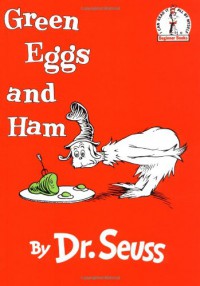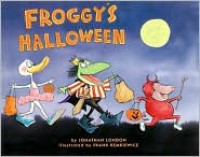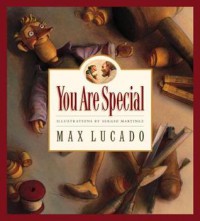The Giving Tree

When it comes to The Giving Tree, I would use this book for kindergarten to second grade. As to how I would use this book, it is fairly simple. After reading the book I would work with the class to complete a graphic organizer of what trees can do for us according to the book. Then in order to have my students think a little deeper into the matter, I would have them write or draw three things someone else does for them. After they had completed that, I would ask them to think of three things they can do for other people they know. Naturally, I would have the students record these three things on the same paper so that I could look at them later. If time did allow, I would have the students share their ideas with the class. Also, I would encourage my students to actually try to do one of the three things they said they could do for somebody.
Green Eggs and Ham

Green Eggs and Ham is the perfect book to use in any classroom from kindergarten to sixth grade. This book is a must read for Dr. Seuss week in any school. Therefore, when I use this book in my future classroom during Dr. Seuss week, I plan to use it to promote trying new things. Everyone knows that trying something new can be scary, even for adults. So after reading the book, I plan to have each of my students either write or draw one thing that they would like to try, but either do not have the opportunity to try, are to scared to try, or just do not think they would like it. Then throughout the week I would try to present as many opportunities as I possibly could for the students to try what they had written or drawn on their paper. Of course one of these opportunities would have to involve the students trying green eggs and ham.
The True Story of the Three Little Pigs

I could use The True Story of the Three Little Pigs in a few different ways, all of which I would do in my class for second to sixth graders. The first way is in a fairytale study on different versions of the same story. In this study, I would have my students read different versions of The Three Little Pigs and then have them compare and contrast each version. However, for fourth grade through sixth, I would use this book to mimic the judicial system. In other words, I would have the students work in groups to present a case either for or against the wolf. In their case, they would have to come up with three details from the text to act as evidence. To make it a bit more fun, the students would have to come up with what they thought would be a suitable punishment for the wolf if they believe he is indeed guilty. Once a group presents their case for or against the wolf, I would have the rest of the class act as a jury and give a thumbs up if they agree with the group or thumbs down if they do not.
The Three Little Pigs

When using the original story of The Three Little Pigs, I would use it for second to sixth graders to complete a fairytale study. For this particular study with this book I would have my students read different versions of this story, then compare and contrast each of the different versions. I would then probably have the students write a small report on which version they preferred and why which I would have them share. If I did have to use it with kindergarten or first, I would use it in a readers' theater center, because even if the students can not read the story, odds are they know the story enough to act it out.
The Three Little Wolves and the Big Bag Pig

This book as a perfect book to include in a fairytale study of different versions of The Three Little Pigs. Although I would have no problem reading it to kindergarten or first grade, I would only do a fairytale study of different versions of one story with second through sixth grade. I say this because, over the course of the study, I would have the students record the differences and similarities they see in each fairytale. Now while doing this as a class would be fine for kindergarten and first, I would want the students to read the stories and record their finding on their own. While I may not do the fairytale study for kindergarten and first with this book, I would still use it to show how it is important to be kind to others, even if they are not nice to you. If needed I would also use this approach to the book for second grade to third.
Three Hens and a Peacock

To start off with, I believe this book is great to use with kindergarten up to sixth grade. As for how I would use this book, there are two different ways. The first way I would use this book is a compare and contrast with another version of The Three Little Pigs with second to sixth graders. The second way I would use it, which I like a little better, is to discuss the subject of how everything is not how it appears to be with kindergarten and first graders. In other words, while we think that one person has it easier than us, in actuality they actually have it just as hard or harder. Then I would have the students turn and discuss one instance where they thought one thing and it turned out to be totally different with their partner.
A Porcupine Named Fluffy

This book is great to use with kindergarten up to second grade. A Porcupine Named Fluffy is a great book to use on the first day of school in order to build acceptance for kindergarten and first grade. However, with second grade, I would use it to introduce adjectives. I would do this by reading the book while stopping to ask the students if they heard any words that described anything throughout the book. If they did hear one, I would write it on the board to be discussed later. After the book had been read and we had gone over adjectives as a whole, I would have the students write a list of five to ten adjectives that they feel described them.
Have You Filled a Bucket Today?

This is a great book that I would read on the first day of school to all students in kindergarten to sixth grade. It gently reminds students that the things they say can hurt other people. So, in order to drive this point home, after reading this book I would have students fill each other's buckets, literally. In order to do this, I would place a small bucket, or box, for each student in the back of the room and then have a station set up beside it with sticky notes and pencils. I would then challenge my students to write something nice about each other on the sticky notes and drop then in the person's bucket throughout the day. This way the students are literally filling each other's' buckets with encouraging words daily. However, instead of letting the students see what was placed in their buckets at the end of the day, I would probably type up all of the notes to give the students the next day. This way I could make sure nothing mean was placed in each bucket, but also the students would not know who wrote what.
Flat Stanley

While I have seen Flat Stanley used in guided reading for second grade, I personally would use this book for a fourth-grade project like my fourth-grade teacher did. To begin with, my teacher gave all of use three printouts of Stanley at the end of our third-grade year. This was because we would need to start on a project that we would have to complete the next year. Over the summer we were tasked with taking or sending Stanley to four different places outside of Alabama. By sending Stanley I mean that we were allowed to send Stanley to family members that either did not live in Alabama or were traveling somewhere outside of Alabama. During Stanley's visits, we were to take pictures of what he saw with him in the picture. Then once school started back we were two make two posters displaying the pictures we took and telling about the places Stanley visited. At the same time, we were reading the book in class in order to get the thought process behind this assignment.
Although I absolutely loved this project and would totally use it in my classroom, I would change a few things. First off I would ask the third-grade teacher if she could present the book towards the end of the year. This way the students know the story and better understand this project. Secondly, I would not require the places Stanley visits to be outside of the state. Instead, I would probably just say it had to be outside the town or city in which I was teaching. I say this because not everyone can afford to go on vacations, but surely everyone could make a quick trip to a park or even the store. Also, I might even allow the students to use their house as a place Stanley visits. Lastly, I would not require Stanley to be in the pictures. This way any students that did not receive a Stanley at the end of the year or had moved to the school that year would not be punished because they did not have one. Other than that I would keep the whole project the same.
 1
1
Wacky Wednesday
![[ { WACKY WEDNESDAY (I CAN READ IT ALL BY MYSELF BEGINNER BOOKS (LIBRARY)) } ] by Dr Seuss (AUTHOR) Sep-12-1974 [ Library Binding ] - Dr Seuss](http://booklikes.com/photo/max/200/300/upload/books/43/56/9df23cb530cff5fc5e63d82adead4f77.jpg)
Wacky Wednesday is a really fun Dr. Seuss book that I would easily use with kindergarten all the way to second grade. In order to use this book in my classroom, I would first wait till it was Dr. Seuss week and Wednesday as well. Then while reading the book to the students I would have them point out the wacky thing on each page. For example a shoe on the wall. While doing this I would be sure to have the students keep track of how many wacky things they find on each page. This way we would be able to make sure we found all of the wacky happenings, due to the book telling how many wacky things are on each page. This, in turn, would be extra practice with counting for any student that needs it. Then I might have them draw a picture with an assigned amount of wacky things in it. These then could be shared with the class and hung up on a wall.
Froggy's Halloween

Froggy's Halloween is a great read for any student in any grade, kindergarten to sixth. However, while I would still read it around Halloween time to kindergarten through second, I would mainly use is for third through sixth. The way I would use is would be having the students write a summary of the book. To further explain this, toward the beginning of October I would allow my students to select from a big selection of Halloween picture books, this one included, to read. Then once the students have read their selected book, I would ask them to write a summary of their chosen book on a slip of paper, which would then be placed in a brown paper bag that they had decorated. Once everyone had completed their summaries, I would have the students share and then use the summaries for a cute bulletin board for the rest of the month. To modify this for kindergarten to second grade, I would probably read the book to the class and then have them draw a picture of their favorite part of the book.
The Legend of Spookley the Square Pumpkin

Having read this book when I was in fifth grade, I would have to say that it is a Halloween favorite. Not only does it promote being different, but it also is just a fun read that practically any student would enjoy. With that in mind, I would definitely use this book with students in kindergarten all the way to sixth grade. For the younger grades, kindergarten to second, after reading the book I would have them draw their own pumpkin. I would stress that it could be any shape, color, and size they wanted. Then I would have them write one thing on the pumpkin that they think makes them different. Once everyone had completed their pumpkin, I would allow the students to share and then hang them up in the hall for the school to see.
When it come to the older grades, third through sixth, I would use this and other Halloween picture books to work on summarizing. What I mean is that towards the beginning of the month of October, I would have each of my students read one Halloween picture book. Then on a strip of paper, they would have to write a summary of the book, which they would then slide in a brown paper bag they had decorated. Once everyone's was complete, I would have them share their summaries. After they shared I would use the completed projects in a cute bulletin board for the remainder of the month.
Should I Share My Ice Cream?

This book is a great book to read at the beginning of the school year to students in kindergarten to second grade. Its simple story promotes sharing in a fun and colorful way. After reading the book to my class I personally would talk to the students about different scenarios that could call for sharing something with their friends. I might also have the students draw a picture of a time that they shared something with someone and have them tell me how they felt after sharing as I hung them up on the wall. For second grade I would still use this idea, but instead of drawing a picture, I would have them write about a time they shared with a friend.
There Was An Old Lady Who Swallowed A Fly

I believe this is a great book that I would use with kindergarten through second grade. It is a fun read that can keep them entertained, especially when one uses resources along with it. One such example of these resources would be puppets and another would be a song. As for how I would use this book, I would personally use it for sequencing purposes. This book is all about the order that the old lady swallowed things in. Therefore, after reading the book I could test the students’ comprehension of the book by getting them to put some form of manipulatives that represent the animals she swallowed in the order she swallowed them. This would work as a quick and easy assessment while giving me a quick overview of who was paying attention.
You Are Special

You Are Special is a personal favorite of mine. While I do believe I could better use this book with kindergarten to second, I would not complete throw it out on using with any older grades I may teach. In my classroom, I would probably read this book at the beginning of the year. Then after the book has been read to the students I would go over how it is okay to make a mistake. I would also relate the black dots that the townspeople give out when someone makes a mistake to how mean remarks can stay with a person for a long time. Then I would try to point out that the mean things people can say only matter if you let them.
Room on the Broom

Room on the Broom is a fun book that I got to see being used in my placement this semester. Therefore I would personally use this book for kindergarten to second grade. The way I would use this book is, in the same way, I saw it used first hand. I would first use it to introduce a few new words to the students' vocabulary, such as cauldron and cloak. Then when reading the book I would use it to provide practice with rhyming words for my students. To do this I would read the first two pages with few pauses and then I would start to stop at the end of a sentence. This would give the students an opportunity to call out a rhyming word that they believe is used where I paused in the story.
 1
1



